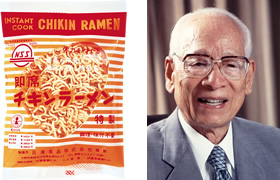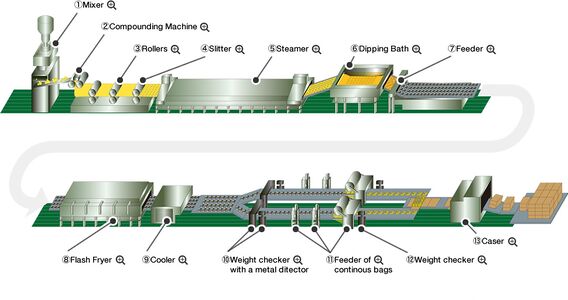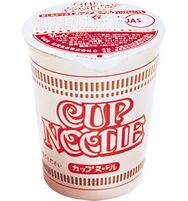Course:FNH200/Projects/2021/Instant Noodles
Instant Noodles: Origins & Popularity today

Despite their immense popularity, instant noodles are a relatively new food item. While seen as a cheap and easy meal made for college students, the origins of the noodle dish are much more romantic.
Instant noodles first gained traction among many Asian countries quickly experiencing an increasing demand across the globe - with approximately 95.4 billion servings consumed annually worldwide. Its quick rehydration rate (hence instant noodles), texture, flavour, long shelf life and low price are among the major contributing factors to its popularity.[1]
Instant noodles were first created in Japan by a manufacturer called Nissin foods in response to the issue of hunger 10 years after Japan's defeat in World War II. In 1958 Japan’s Momofuku Ando made the first instant noodle inspired by fried tempura made by his wife - its first brand name was Chikin Ramen.[2]
Later in the company's history, Nissin started to improve its international production. It first cooperated with South Korea Miyaki food company in 1963, Then in 1968 with an international food company in Taiwan to launch the chicken soup taste instant ramen. At first, the market of noodles made by Japanese formula was not good, but after improving the sauce and the noodle it became one of the more popular foods in Taiwan.[3] Cup noodles (flavoured noodles placed in an upright Styrofoam container) were introduced in 1971, considered a totally new instant noodle.[2]
60 years after the first invention, China reinvented the instant noodle from Japanese instant noodles made by frying techniques to Chinese instant noodles made by steam and boil technology.[4]
How it's made:

Manufacturing Process[5]
1. Mixer – wheat flour and water are mixed and kneaded for 15-20 minutes.
2. Compounding Machine – the dough is fed through dual rollers to form a sheet and is left to mature.
3. Rollers –10mm-thick dough sheet is pressed to approximately 1mm by more rollers.
4. Slitter – rotating blades cut the dough sheets into wavy, thin noodles to prevent sticking.
5. Steamer – noodles are steamed at 100°C for 1-5 minutes to form highly-digestible pregelatinized starch.
6. Dipping Bath – noodles are dipped in a bath of seasoning.
7. Feeder – noodles are cut to 40-70cm in length and put into square or circular serving molds.
8. Flash Fryer – metal molds are put into 140-160°C oil for 1-2 minutes, reducing the moisture content to 3-6%.
9. Cooler – hydrated noodles are air-cooled and checked for quality.
10. Weight Checker and Metal Detector – noodle servings are weighed and checked for metal material, those that fail are automatically discarded.
11. Bagging – noodles are hermetically packaged into film-lined sleeves and cups along with seasoning and garnish.
12. Weight Checker – weight is checked again, those that fail are discarded.
13. Caser – finished product is packaged into cardboard cases for distribution.
Additives and Their Purposes[6]
Guar gum and xanthan gum – added to enhance texture, elasticity, and flavour.
Kansui (potassium carbonate and sodium carbonate) – added to create a unique texture.
Polysaccharides (algin and pectin) – added to increase viscosity and act as a stabilizer.
Plant lecithin – added to act as an emulsifier.
Colours (gardenia dye and carotene)– added to maintain noodle colours.
- Vitamin E – acts as an antioxidant to prevent the oxidation of oil and fats.
- Fortifiers (vitamin B1, vitamin b2, calcium) – added to increase the nutritional value of the product
*Added nutritive materials like vitamins, minerals, and amino acids are not considered food additives in Canada.*
New Cooking Techniques: Blow Dry Method[7]
While blow-drying is not a new dehydration method for instant noodles, it was unpopular in the past because technological constraints created a final product that took two extra minutes to rehydrate and had an undesirable mouthfeel. When compared to its deep-fat fried counterpart, consumers reported the blow-dried noodles to be too rubbery. However, with technological advancements and changes to ingredients in the 1990s, a better blow-dry process was developed; the new method involved exposing the noodles to 80°C hot air for 30-60 minutes. Alongside rising consumer health concerns, the “non-fried” noodles found popularity as a healthier alternative due to their relatively low calories.

Preservation
Instant noodles utilize multiple perseveration strategies to achieve their impressive unrefrigerated shelf life, especially when compared to traditional noodle dishes.
The main method of preservation is the reduction of water activity through the deep-frying process whereby moisture is rapidly evaporated from the noodles. This process also leaves behind tiny vacant holes that expedite the rehydration process.[7] With the dehydrated noodles only having 3-6% moisture content, the lowered water activity prevents microbial activity, enzymatic activity, and chemical reactions that require free water to occur. Additionally, the added salt, sugar and seasoning bind to water and further reduce the available free water.[6]
Food deterioration often happens due to fat oxidation in food products and is a particular concern for deep-fried instant noodles. To combat this issue, the noodles are not exposed to high temperatures for prolonged periods of time. Furthermore, the added vitamin E has natural antioxidant effects that help alleviate the issue.[6]
Finally, the packaging for instant noodles plays a crucial role in its preservation. Because hydrated foods have low water activity, they are hygroscopic and readily pick up moisture. For this reason, instant noodles are often packaged in film-lined sleeves and foam cups that not only block the transmission of water vapour, but also oxygen, light, and heat. The bulk cardboard cases and foam cups also provide some physical protection for the noodles during distribution.[6]

Modes of Packaging
Water activity, pH, and fat content are some of the most important properties that packaging options must keep in mind.[8] Instant noodles are typically packaged in two common ways - sleeves and cups, or more recently, bowls. Sleeves, a polyethylene bag, were the first used packaging option for instant noodles, followed by Nissin's debut of cup noodles in 1971 which used a paperboard material before quickly changing to Styrofoam. This iteration of instant noodle packaging followed inventor Momofuku Ando's witnessing an American breaking up his instant noodles from the sleeve and transferring it to a cup.[9] Cup packaging is typically thermally sealed with peel-away plastic film covers. The whole cup is wrapped in polyethylene to provide a water-resistant layer. In both sleeves and cups, instant noodle add-ins (flavouring powders and dehydrated garnishes) are separately, but internally packaged - garnishes and/or sauces typically in plastic pouches, and flavouring powders in aluminum sachets.[8]
Health concerns
Instant noodles are usually composed of a lot of carbohydrates, sodium, and fat. As a processed convenience food, instant noodles can meet the daily needs of an adult. Low-frequency consumption of instant noodles will not cause harm to the body, but long-term consumption of instant noodles may cause negative effects on the body, including obesity, nutritional imbalance, heart disease and other diseases.
1. Instant noodles are low in vitamins and minerals. Long-term consumption will affect the body's nutritional supply, especially for children and adolescents. It will cause their brain development and thinking disorders, and they will have problems such as inattention. Furthermore, instant noodles involve plenty of sodium and fat. In a healthy diet, intake of both substances should under controlled since excessive intake can lead to the increased risk of obesity, high blood pressure, and coronary heart disease. This is especially true for children with immature kidney development. Without the ability to excrete too much sodium, the risk of illness will increase accordingly.[10]
2. Instant noodles are a staple food with wheat flour as the main raw material. Nutrient loss can occur during the grinding process of wheat. Long-term consumption of instant noodles will increase the risk of neural tube defects caused by insufficient folic acid and the risk of anemia caused by nutritional deficiencies. In addition, the fine flour used for instant noodles contains less cellulose. Long-term consumption of instant noodles can cause constipation and ultimately increase the risk of bowel cancer.[11]
3. A Nigerian study investigated 6 kinds of instant noodle packaging in Nigeria. Heavy metals such as cadmium, lead, mercury, arsenic, aluminum, and chromium are found in some instant noodle packages. Continued consumption of these noodles may lead to heavy metal poisoning and damage to neurons and kidney function. Although some heavy metals do not exceed the maximum amount, their consumption can still be unsafe due to the capacity to bioaccumulate these pollutants. Eating such contaminated instant noodles will have serious harmful effects on humans.[12]
Exam Question:
Instant noodles are an extremely popular food item throughout the world; most households probably have a stash of the tasty meal at home for times when we need to prepare something to eat quickly. But, it is also just as likely that most of us don't know how and why the noodles were made to last so long; that is why we think that this is a very interesting topic for everyone to learn about.
Question: Which of the following are preservation methods used in the manufacturing of instant ramen? (Correct answers in bold).
- reduction of water activity by deep frying
- perforated polyethylene coating
- addition of vitamin E
- specialized packaging
- fermentation
References
- ↑ Gulia, Neelam; Dhaka, Vanada; Khatkar, B.S. (02/24/2014). "Instant Noodles: Processing, Quality, and Nutritional Aspects". Critical Reviews in Food Science and Nutrition. 54: 1386–1399. doi:10.1080/10408398.2011.638227 – via Taylor & Francis Online. Check date values in:
|date=(help) - ↑ 2.0 2.1 "WINA History of Instant Noodles". World Instant Noodle Association. 2016. Retrieved 08/08/2021. Check date values in:
|access-date=(help) - ↑ Zhang, Na; Ma, Guansheng (09/2016). "Noodles, traditionally and today". Journal of Ethnic Foods. 3: 209–212. doi:10.1016/j.jef.2016.08.003 – via Science Direct. Check date values in:
|date=(help) - ↑ "Chinese Food Producer Jinmailang Invents Second Generation Instant Noodles". PR Newswire Asia. 08/21/2018. Retrieved 08/08/2021. Check date values in:
|access-date=, |date=(help) - ↑ "WINA Instant Noodle Manufacturing Process". World Instant Noodle Association. 2016. Retrieved 08/08/2021. Check date values in:
|access-date=(help) - ↑ 6.0 6.1 6.2 6.3 "WINA Additives Information". World Instant Noodle Association. 2016. Retrieved 08/08/2021. Check date values in:
|access-date=(help) - ↑ 7.0 7.1 "Instant Noodle Processing: Blow Dry Method". Hi-Tech Instant Ramen. Retrieved 08/08/2021. Check date values in:
|access-date=(help) - ↑ 8.0 8.1 Ling, Qingyue (2010). "Chapter 7: Packaging of Noodle Products". Asian Noodles: Science, Technology, and Processing. John Wiley & Sons, Inc. pp. 155–181. ISBN 0-470-17922-8, 978-0-470-17922-2 Check
|isbn=value: invalid character (help). Retrieved 08/08/2021. Check date values in:|access-date=(help) - ↑ Sanches, Rudy (08/18/2020). "The History of Instant Ramen". DIELINE. Retrieved 08/08/2021. Check date values in:
|access-date=, |date=(help) - ↑ Adejuwon, Ololade H. Jideani, Afam I. O. Falade, Kolawole O. (July 2019). "Quality and Public Health Concerns of Instant Noodles as Influenced by Raw Materials and Processing Technology". Food Reviews International: 276–317.CS1 maint: multiple names: authors list (link)
- ↑ Hyun Joon Shin, Eunyoung Cho, Hae-Jeung Lee, Teresa T. Fung, Eric Rimm, Bernard Rosner, JoAnn E. Manson, Kevin Wheelan, Frank B. Hu. "Instant Noodle Intake and Dietary Patterns Are Associated with Distinct Cardiometabolic Risk Factors in Korea". The Journal of Nutrition. 144: 1247–1255.CS1 maint: multiple names: authors list (link)
- ↑ Charles, I.A., Ogbolosingha, A.J. & Afia, I.U. (2018). "Health risk assessment of instant noodles commonly consumed in Port Harcourt, Nigeria". Environmental science and pollution research international. 25: 2580–2587.CS1 maint: multiple names: authors list (link)